
About UsThe Numismatic Bibliomania Society is a non-profit organization promoting numismatic literature. For more information please see our web site at coinbooks.org SubscriptionsThose wishing to become new E-Sylum subscribers (or wishing to Unsubscribe) can go to the following web page link MembershipThere is a membership application available on the web site Membership Application To join, print the application and return it with your check to the address printed on the application. Membership is only $15 to addresses in the U.S., $20 for First Class mail, and $25 elsewhere. For those without web access, write to: David M. Sundman, Secretary/TreasurerNumismatic Bibliomania
Society AsylumFor Asylum mailing address changes and other membership questions, contact David at this email address: dsundman@LittletonCoin.com SubmissionsTo submit items for publication in The E-Sylum, just Reply to this message, or write to the Editor at this address: whomren@coinlibrary.com
BUY THE BOOK BEFORE THE COINYou won't regret it! |
- WAYNE'S WORDS: THE E-SYLUM OCTOBER 19, 2008
- FANNING BOOKS OCTOBER 28, 2008 SALE CATALOGUE ARRIVES
- BOOK REVIEWS: NATIONAL COMMEMORATIVE MEDALS OF THE UNITED STATES
- BOOK REVIEW: IN YANKEE DOODLE.S POCKET BY WILL NIPPER
- MINT DIRECTOR TRIVIA
- MORE ON SECRET ARTIST SIGNATURES
- QUERY: ONLINE BOOK SEARCH SITES
- MORE ON MEDAL DESIGNER DORA DEPEDERY-HUNT
- FIFTY STATES QUARTER SERIES ENDS WITH STRIKING OF HAWAII QUARTER
- PROFESSOR TRACES U.S. CENT COPPER TO THE MINES WHICH PRODUCED IT
- AMERICAN BANKNOTE SUBSIDIARY INTRODUCES BIODEGRADABLE CREDIT CARD
- CHARGES FILED IN NEW ZEALAND VICTORIA CROSS THEFT
- TURKEY'S CENTRAL BANK CRITICIZED OVER WOMAN'S PORTRAIT
- QUERY: VERMONT FREEDOM CURRENCY
- BANK PURCHASES COINS OF THE KNIGHTS OF MALTA FOR DISPLAY
- HOLLOW SPY COIN REPLICAS OFFERED
- FEATURED WEB PAGE: WIKIPEDIA'S COINS OF THE HAWAIIAN DOLLAR
WAYNE'S WORDS: THE E-SYLUM OCTOBER 19, 2008
 Among our recent subscribers is Ignacio
Henao. Welcome aboard! We now have 1,207 subscribers.
Among our recent subscribers is Ignacio
Henao. Welcome aboard! We now have 1,207 subscribers.This week we open with an update on David Fanning's upcoming numismatic literature auction, and reviews of new books by Bill Swoger, John Dean and Will Nipper. In topics continued from earlier issues we discuss Mint Director trivia, secret artist signatures, and coin and medal designer Dora dePedery-Hunt.
In the news, charges are filed in the New Zealand medal theft case, the fifty states quarter series nears its end, and a professor traces copper used in U.S. cents back to the mines it came from.
To learn which future numismatic collectible is made from alfalfa, beets, corn, potato skins, switch grass and wheat, read on. Have a great week, everyone!
Wayne Homren
Numismatic Bibliomania Society
FANNING BOOKS OCTOBER 28, 2008 SALE CATALOGUE ARRIVES
My copy of David Fanning's October 28 numismatic literature auction catalogue arrived Tuesday. Wow! - what a treat. It's a beautifully presented catalog with color illustrations. David has issued eight fixed price lists to date (some of which were in hard-copy form and some of which were electronic), but this is his first auction sale. What a debut! Comments, anyone?David F. Fanning writes:
I have been asked about the deadline for the sale, which is given in the catalogue as 8 p.m., eastern time, on October 28. As my phone will probably be very busy around the closing of the sale, I.ve decided to adopt the practice of accepting bids until ten minutes have elapsed without a phone call. This should allow us to accommodate callers trying to get through toward the end of the sale.
BOOK REVIEWS: NATIONAL COMMEMORATIVE MEDALS OF THE UNITED STATES
The two books will forever be confused, forever be compared and always be judged against one another. Note to numismatic authors: If you learn someone else is writing a book on the same subject as your own, try to join forces; the end product will be better than two separate books. In this instance, however, both authors tell me they were unaware of the other's effort prior to publication.
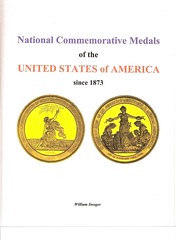
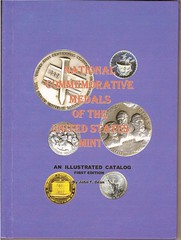
But more important, both were self published. And therein, perhaps, are lessons to be learned. Self publishing has many pitfalls. Most important: Hire an editor. You need someone else to view your work, someone who can say "Don't do that!" Perhaps you need a technical editor as well to insure numismatic accuracy.
You will also need a graphic artist who will shape your text and illustrations into an attractive package. And unless you are a marketing expert you will also need some help in getting the book sold, not just to the coin field, but also into libraries and book stores. Are you certain you want to self publish? Publishers earn every cent of profits for their combined professional efforts performing all these functions.
Let's compare the two books. Swoger covers 71 medals in 300 pages. Dean covers 69 medals in 90 pages. Obviously Swoger contains more text. Dean devotes a full page to each medal. Don't do that! I have suggested to authors often, don't put everything -- illustrations, description and background text -- into a box, full page or not. Also ditch spreadsheets. Both of these formats limit your thinking and the amount of information you can use. Create as few or as many pages as necessary to illustrate, describe and tell about each item.
Dean crammed everything into a one page for each medal with the result that the text size had to be decreased. The smallest type size my computer will allow is 8 point, Dean's must have been less than that - too small on the printed page for these old eyes. I hate to have to pick up a loupe just to read the text.
Both authors included "Turner numbers" from an earlier listing of these medals by Howard L. Turner, who ran his list in The Numismatist (July 1968) with three additional supplements (Sept 1977, Nov 1985, Nov 1989). It is convenient now to get all these consolidated between bound covers with expanded information.
Dean also put the varieties in an appendix at the end of the book instead of with the medal itself. Don't do that! Everything about an individual item should be together.
Dean overlooked one medal -- the 1970 United States Weather Service Centennial Medal -- but so did Turner. Swoger includes it (his number 205). Dean also omitted one of the 1976 National Bicentennial Medals (Swoger includes, his number 521).
However Dean includes one that Swoger omitted -- the 1962 Douglas MacArthur Medal, first issued as his Congressional Medal (Turner 11, Dean D1962-2).
Swoger, to his credit, lists a variety of the 1976 Colorado Statehood Centennial Medal, where the reverse of this medal was muled with the obverse of the Denver Mint Building Medal (Swoger 53II-X).This medal is notable in that the D mintmark is on both sides. Dean omits this medal.
Swoger also lists an extensive amount of associated items (mentioned here in E-Sylum October 8, 2008, vol 11, no 32, art 14). He does this for just about every item, as this adds interest to the series.
Swoger's shortcomings are numerous. Frequent use of lines of text in colors, frequent underlining of text and headlines, numerous lines of differing sizes, odd type faces at times trying to match type style on medals. Don't do that! Just because your computer allows you to do these things doesn't mean you should in a formal book. Further, his index is in spreadsheet format. Don't do that!
The serious collector of this interesting series of U.S. Mint medals will need to obtain both books. Dean's is modestly priced at $24.95. Swoger's is overpriced at a whopping $225. Don't do that!
Get Swoger for the extensive background material, the associated item illustrations, and the information not elsewhere available. Get Dean for its convenient size; you might even want to use a copy of Dean as a checklist, it is easily carried to a coin show for a handy want list.
Dean has a web site where ordering information is available: www.jtdean.com/USMedals/medals.html
I bought my copy of Swoger from the author. It may be available from numismatic book dealers, but Rich Hartzog is the only listing I found: www.exonumia.com/books.html
BOOK REVIEW: IN YANKEE DOODLE.S POCKET BY WILL NIPPER
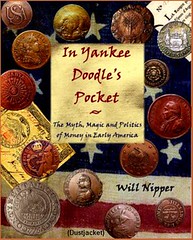 Last week Tom Kays submitted a review of Will
Nipper's new book; this week it's my turn. Many thanks to Will who
provided copies of the text and images reproduced here.
Last week Tom Kays submitted a review of Will
Nipper's new book; this week it's my turn. Many thanks to Will who
provided copies of the text and images reproduced here.It was a delight to open the package which arrived in the mail this week with a copy of In Yankee Doodles Pocket . The Myth, Magic and Politics of Money in Early America. It's a beautiful and welcoming 568-page hardcover work with a glossy color dust jacket. The blue cloth cover and spine are lettered in a shiny copper color, along with an image of the deer from the Higley copper. As Tom noted, it's a lavish work that I'll make room for on my shelf. A lesser work will have to go.
We bibliophiles all know the first question visitors ask when first encountering our libraries: "Did you read all of these books?" For most of us, the honest answer is "No" (if not, "Hell, No!"). As much as I love having quick access to my books for reference, only a select few are page turners to be read from beginning to end. Will's book joins that elite club in my eyes.
Like classics such as Neil Carothers' Fractional Money and Willem's The United States Trade Dollar, I think this book is one numismatists will want to enjoy from cover to cover. Here it is, all in one volume - the complete sweep of American numismatic history from barter through the early Federal issues. If I were Library Czar, a copy would be placed in every high school, college and university library in the country.
The opening paragraphs of the book's preface properly set the stage.
It was not always so. As inevitable as America's success seems to have been, the fact remains that most of our early history was spent a false step from disaster. Though it happened very quickly by history's standards, transforming a motley collection of European outposts into a wealthy and powerful young nation was quite an ordeal.
The monies of pre-1840 America were both witnesses to this remarkable change and vital instruments of it. They tell of imperial and personal triumph . and folly. They celebrate our remarkable capacity for invention and adaptation. More importantly, they speak of the great American struggle between diversity and unanimity that was and remains a defining national principle. As we evolved from pluribus to something approaching unum, so did our money.
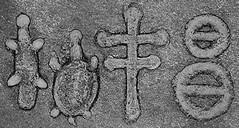 From p36: a soapstone trade silver mold with
reservoirs for (left to right) a beaver, a turtle, a Cross of Lorraine,
and two sizes of buckles... This inch-thick mold was found near the
intersection of the Wabash river and the Ohio/Indiana border.
From p36: a soapstone trade silver mold with
reservoirs for (left to right) a beaver, a turtle, a Cross of Lorraine,
and two sizes of buckles... This inch-thick mold was found near the
intersection of the Wabash river and the Ohio/Indiana border.
From the first chapter:
Even a king, however, cannot watch everyone, especially when his colonies are remote and immersed in a complex socio-political landscape. When the Pilgrims arrived in Massachusetts, for example, the Spanish already had occupied Florida for over half a century and the nearby West Indies for even longer. French Huguenots had attempted settlement in what are now the Carolinas. Coureurs de bois (.runners of the forest.) were roaming France's wilderness empire and the Dutch would soon have a foothold in what is now New York, incorporating in 1655 a 1638 settlement of Swedes and Finns.
It would not be long until African traditions and slave trade economics found their way to America. Then there were the Native American populations. Each group coveted things that the others possessed. Only law and lack of currency stood between these groups and trade. Both constraints proved weak deterrents, however, as colonists circumvented the former and adapted or invented the latter. These were early signs of American independence.
The book's long-view historical perspective reminds me of an author I mentioned last week, John Steele Gordon, whose 2005 Empire of Wealth: The Epic History of American Economic Power is one of my favorite non-numismatic books.
For an idea of the book's broad coverage, look no farther than the table of contents. There are twelve chapters in four sections. Here are the topics covering in just sections three and four, spanning pages 79 through 232:
Section III: The Incidentals (1550 to 1820)
5: Britannics Realm
Regal, Commonwealth and Patent Coinages
Contemporary Counterfeits and the British Evasion
Island Coins and Tokens
Privately Issued Tokens
6: Spain and Her New World Colonies
The Earliest New World Coinage
The Age of Cobs
Pistareens and Other Domestic New Plate Coinage
Colonial Milled Coinage
7: The Chorus
The Netherlands
France
Portugal and Brazil
Tools of the Trade
Section IV: Early American Coins and Tokens (1616 to 1840)
8: Colonization (1616 to 1763)
A Rude Beginning: Sommer Islands Coinage (Ca. 1616)
Massachusetts Silver Coinage (1652 to 1682)
Maryland's Lord Baltimore Coinage (Ca. 1659)
St. Patrick or Mark Newby Coppers (Ca. 1667 to 1672)
American Plantations Tokens (1688)
Elephant Tokens (Ca. 1694)
French Issues Used in Louisiana and Canada (1640 to 1764)
Oddfellows: Miscellaneous Early Tokens (Ca. 1665 to 1715)
William Wood's Coinages (1722 to 1724, 1727 and 1733)
Value Me as You Please: Dr. Higley's Copper Threepence (1737 to 1739)
Hibernia Voce Populi Tokens (1760)
Attesting to the author's thoroughness is this illustration of the Bar Copper showing the coin together with actual examples of the colonialera buttons the design was modeled after. I've read about the coin's connection to button designs, but don't recall ever seeing such buttons illustrated.

One numismatic item discussed in the book that I hadn't encountered before is the Ferryland, Newfoundland "DK" token, perhaps the first such token made in North America.
For this purpose, Kirke ran a .common tavern. in his own house. It seems likely that the lead tokens were used as small change in the tavern. Based on the sizes of the recovered pieces, units of one, two and three were used, though just what the unit was is in question. The .DK tokens. differ from most Elizabethan lead tokens in that they are struck rather than cast. Based on research done by Ray Williams and presented at the 2006 C4 convention, it appears that the weights of the tokens correspond to musket balls of known calibers. Since musket balls were accepted in their most useful (spherical) form as half-farthings, the reason for pounding them flat and stamping them with David Kirke's monogram is a mystery
The book also carefully illustrates important coin design elements. Here is just ONE of the line drawings illuminating the description of New Jersey cent designs:

Another important feature that I really appreciated seeing were the charts showing the linkage of various designs across coin types, such as this chart showing the linkage between the Immunis Columboia and Constellatio Nova coinage:
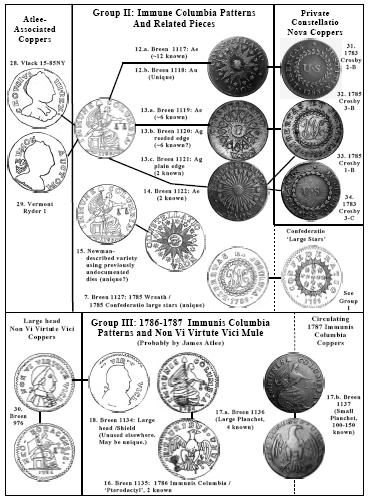
For more information on the publisher's web site, see: In Yankee Doodle's Pocket (http://www.bowmanstonepress.com/index_files/detailspage.htm)
The book is well annotated with (count 'em) 1,014 endnotes and seventeen pages of references to works in print, conversations and correspondence (public and private), and online and other works.
If I can sum up my review in one word, it would be this: WOW!.
Author Will Nipper adds:
| 'Extraordinary Merit' NLG Award Winner Coin Collecting Boards of the 1930s & 1940s: A Complete History, Catalog & Value Guide. $39.95 plus $5 shipping Buy directly from the author and get your copy signed. I also sell my several other books. POB 20892 Bradenton, FL 34204 | 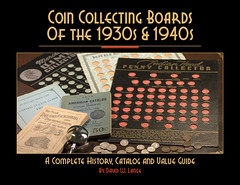 Visit my website: |
MINT DIRECTOR TRIVIA
Regarding last week's Featured Web Page, Mark Borckardt writes: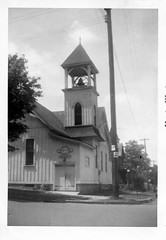 I really like the Mint Director's web site. But I
am confused about the title. David Rittenhouse is generally considered the
first Mint Director in 1792. Who were the Mint Directors from 1773 until
his appointment in April 1792? Here's some additional trivia about a Mint
director:
I really like the Mint Director's web site. But I
am confused about the title. David Rittenhouse is generally considered the
first Mint Director in 1792. Who were the Mint Directors from 1773 until
his appointment in April 1792? Here's some additional trivia about a Mint
director:Mint Director Jay W. Johnson was born in Bessemer, Michigan (in the upper peninsula) on September 30, 1943 and resided there until he left for college in 1961. My brother (James C. Borckardt, 1956-1974) was born in Wakefield, Michigan (about six miles from Bessemer) on September 28, 1956, and lived in Bessemer in 1956 and 1957. Jay and his family attended the church in Bessemer where my dad was the minister in 1956 and 1957, although when I asked him, Jay apologized for not remembering my dad. Attached is a photo of the Bessemer church.
MORE ON SECRET ARTIST SIGNATURES
Joe Levine writes:
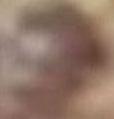 I, too see the face of a mustachioed man with curly
black hair on the right. On the left, however, I see a skull with sunken
eyes. These are as clear to me as my own image I saw this morning at
breakfast on the left lower quadrant of a piece of whole wheat toast!
I, too see the face of a mustachioed man with curly
black hair on the right. On the left, however, I see a skull with sunken
eyes. These are as clear to me as my own image I saw this morning at
breakfast on the left lower quadrant of a piece of whole wheat toast!
Bill Eckberg writes:
 Cartoon signatures are not unprecedented for the
era. James McNeil Whistler transformed his JW monogram into the famous
"Butterfly" signature, which actually does not represent a butterfly at
all, but is a cartoon self-portrait of the upper part of his own face.
Cartoon signatures are not unprecedented for the
era. James McNeil Whistler transformed his JW monogram into the famous
"Butterfly" signature, which actually does not represent a butterfly at
all, but is a cartoon self-portrait of the upper part of his own face.
The dark areas are his hair and eyebrows, and in the 1883 and 1885 iterations on the linked page, he even includes the white forelock of which he was so proud. As far as I know, he signed all of the etchings that he, personally, printed with one form or another of the "Butterfly".
To read the complete article, see: A chronology of Whistler's butterfly signatures (http://www.whistler.arts.gla.ac.uk/HTML/Butter.htm)
This week R.V. forwarded a more conventional coin photo, this one of a pattern, an 1856 Gilt/Brass $1 Gold Dollar with what he terms a .Hand Stamped Date. He writes:
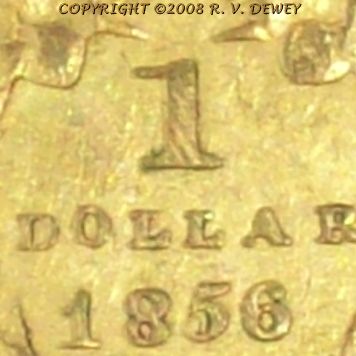
Regardless gilt or solid, my coin is amazingly within 1Kt. gold of that coin (seven years apart one pattern is 12.24Kt. the other; 13.20Kt), 157 year old coincidence? If either coin was meant to deceive someone, they would have been made with 21.5Kt. or 90% gold content, not the 51% and 55% respectively that we see on these two known coins.
A lone 12Kt. or 13Kt. gold coin set on a table with a pile of, .coin of the realm., 90% gold coins could get one shot. The color of the gold from the .known. low gold content tells everyone that these coins were not intended for commerce!
Someone has drawn numerous tiny oblique parallel lines on the numeral 1 above the word dollar and somehow managed to stay within the lines. For lack of a better term; notice the unique .Pinocchio. nose of the numeral 1 extending far to the left, unlike the production gold dollar coins of 1856. Did I mention there are faces in each upper corner?
This Gilt dollar is extremely rare, if not unique! Quite possibly the first .Large Head.! On this day JBL was obviously experimenting with a Brass planchet instead of gold. I am told that, .brass was not really used in the Mint to strike coinage at that time.. I believe more accurately, brass was not known to be used for the tinniest of all United States coins, at that time. Quite possibly the date was hand stamped because an 1856 die did not exist at the .needed. time, since the 1856 Obverse of the $1 Gold Dollar was in a transitional stage. Third time is the charm, and the only change on the reverse would have been the .date. that we see haphazardly stamped on this coin and rising noticeably upward to the right!
After viewing a picture of the Gilt/Brass 1856 gold dollar, Mr. Saul Teichman wrote the following on August 20th 2008: .The 1856 looks like it was a handmade die.. Is it noticeably different than the other 1856 gold dollars? See for yourself, is it unique? What do we really have here? A .one-time. counterfeiter who wants to get caught, shot or jailed, by tediously making 13Kt. .handmade looking. gold coins from scratch, instead of simply and quickly copying an existing 1856 coin.
Perhaps, more likely, we have a previously unknown JBL pattern, trial, or experimental piece? If one believes all the pattern books available, an 1856 $1 Gold Dollar pattern does not exist, period. Do numismatic scholars believe Mr. Longacre decided not to make any $1 Gold Dollar patterns in 1856 or is it more reasonable to believe that not one has yet been found?
It would seem Mr. Longacre forgot to leave us the definitive periodical for identifying 19th Century patterns. For example, it could have been called: My Mint Pattern Coins for Sale, unfortunately we all know JBL did not write that incriminating book. What we should all remember is that history records that he did get caught signing his coins from time to time. How will we identify these forgotten patterns? Consider the following rhetorical questions:
- Is every pattern coin a perfect specimen?
- Should less then perfect patterns be dismissed?
- Are there no more patterns to be discovered?
- Has every pattern now been accounted for?
- Will the missing patterns remain forever missing since we lack a written account from JBL?
Take a close look at the upper-right-hand corner of the photo. Do you see anything unusual? -Editor

QUERY: ONLINE BOOK SEARCH SITES
Scott Semans writes:When I sell out of a worthy title at my own site I remove the price and substitute a "FIND IT" link to a links page with my own favorites. My top recommendation is www.addall.com/Used/ and I occasionally use others such as: www.usedbooksearch.co.uk/cgi/search.cgi , www.bookfinder.com , and www.abebooks.com/servlet/SearchEntry .
I haven't had much luck finding either foreign or English language titles at sites dedicated to French, Spanish, German, and other language sites, but wonder what other readers might recommend.
MORE ON MEDAL DESIGNER DORA DEPEDERY-HUNT
Regarding last week's obituary of medal designer Dora dePedery-Hunt, Robert W. Hoge, Curator of North American Coins and Currency at the American Numismatic Society writes:She was an impressive, creative person. Even works that she fashioned late in her career, at a relatively advanced age for anyone, have a spontaneity and liveliness about them that say much about her personality. Dora built her career in eras and worlds spread greatly apart. She made a successful name for herself on two continents through a lot of effort and talent, and was especially interested in helping and sharing her realizations with young artists following in her footsteps.
She had an openness and sense of humor that were appealing, and which will be treasured by those to whom she offered encouragement and inspiration both through her personal sponsorships and her sculptures.
Thanks for all your marvelous efforts with The E-Sylum.
George Cuhaj writes:
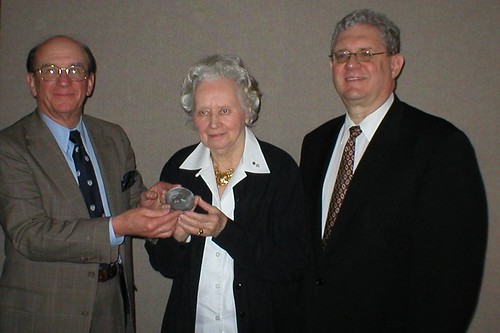
THE BOOK BAZARRE
FIFTY STATES QUARTER SERIES ENDS WITH STRIKING OF HAWAII QUARTER
I was dreading this event for two reasons - the end of a wonderful circulating commemorative program, and the looks I get from my kids when I tell them that when I was born, there were only 48 states in the Union. By the time I made it to grade school the number was 50, but on August 24, 1958 (a day which shall live in infamy) Alaska and Hawaii had yet to become states (January 3, 1959 and August 21, 1959, respectively). -Editor
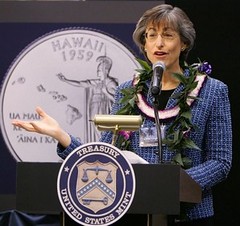 Hawai'i's coin features King Kamehameha I
stretching a hand toward the eight major Hawaiian Islands. Inscribed is
the state motto, "The Life of the Land is Perpetuated in Righteousness,"
in Hawaiian. It will go into circulation Nov. 3, and a ceremony marking
the release will be held at Bishop Square in Honolulu on Nov. 10, said
U.S. Mint spokesman Greg Hernandez.
Hawai'i's coin features King Kamehameha I
stretching a hand toward the eight major Hawaiian Islands. Inscribed is
the state motto, "The Life of the Land is Perpetuated in Righteousness,"
in Hawaiian. It will go into circulation Nov. 3, and a ceremony marking
the release will be held at Bishop Square in Honolulu on Nov. 10, said
U.S. Mint spokesman Greg Hernandez."It's our vision for Hawai'i's future and it shows our respect for all the land," Lingle said of the quarter's design and motto. "And it also shows that although there are many islands, we're united as a state."
Delegation members, including Lingle, state dignitaries and coin collectors, lined up to push a button on a stamp press that spit out individual quarters. Many had their picture taken while flashing the shaka.
For coin collector Rock Villaruel, a guest of design commission member Gregory Hunt, today's event fulfilled a boyhood dream. Villaruel bought his first collecting magazine after becoming interested in coins at age 12. A trip to San Francisco's historic mint years ago ended in disappointment. It was boarded up.
"This is my first time visiting a mint, and it's about time," the 48-year-old Villaruel said.
Kamehameha, who ruled in the early 1800s and unified the islands, was picked instead of designs that featured a hula dancer, Diamond Head on the main island of O'ahu, and a surfer modeled after a young Duke Kahanamoku. For Hunt, the chosen coin is about reminding people that Hawai'i is part of America.
"Sometimes people forget that we are part of the United States," Hunt said. "Visitors to the Islands say, 'You know, back in the states,' and we remind them, 'You mean, back on the Mainland.' "
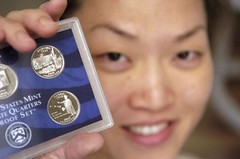 And it's a coincidence, but it's coming up on
our 50th anniversary as a state, we're the 50th state and the 50th
quarter," said Lauren Kamei, a freshman at the University of Hawai'i at
Manoa who served on the commission.
And it's a coincidence, but it's coming up on
our 50th anniversary as a state, we're the 50th state and the 50th
quarter," said Lauren Kamei, a freshman at the University of Hawai'i at
Manoa who served on the commission.To read the complete article, see: Hawaii commemorative coin, the final state quarter, struck at Denver Mint (http://www.honoluluadvertiser.com/apps/pbcs.dll/
article?AID=/20081014/BREAKING01/81014030&s=d&page=2)
PROFESSOR TRACES U.S. CENT COPPER TO THE MINES WHICH PRODUCED IT
 If someone gave Ryan Mathur a penny for his
thoughts, they would learn much more than they bargained
for.
If someone gave Ryan Mathur a penny for his
thoughts, they would learn much more than they bargained
for.Mathur, an associate professor of geology at Juniata College, is the first researcher to discover that tracing the copper used in U.S. pennies correlates directly to the mine that produced the metal.
He plans to publish his findings in the Journal of Archaeological Science in November.
Mathur, who also is a coin collector and a geologist specializing in copper ore deposit research, said copper has two isotopes that give off distinct "geo-chemical signatures" depending on the ratio of each isotope the ore deposit was taken from.
Like many Americans, he just happened to have a penny in his pocket.
He tested that penny - and several others - and discovered that the copper in the pennies minted in the 19th and 20th century came from a single source with a specific signature.
Mathur decided to trace the copper in historic pennies to see if he could match the penny to the deposits where the copper originated.
He cut a sample from the penny - defacing currency in the name of science - and dissolved a portion of the copper in acid.
Mathur then suspended it in a solution and used a mass spectrometer from the University of Arizona to obtain the signature of the metal.
"This is important because we've only had the ability to measure copper isotopes reliably in the past 16 or 17 years, and that's relatively recent in science terms," Mathur said.
At the same time, he had to research the origins of copper bought by the U.S. government during the course of American history.
He delved into the Archives of the U.S. Mint in Philadelphia and found that from 1810 to 1981, 95 percent pure copper was used to mint pennies.
Copper used to mint pennies from 1810 to 1835 came from a site in Cornwall, England.
From 1835-44, the U.S. government bought copper from a variety of sources. Starting in 1845, most of it came from a giant deposit in Michigan.
Then, in 1872, the U.S. began purchasing copper from sources around the world as a way to protect domestic resources. The government later returned to using copper from Montana and Arizona, Mathur said.
To make the link between currency and the copper site, Mathur spent $150 to purchase an 1810 penny from a Huntingdon coin dealer.
Then he hunted down a sample from the Cornwall mine at the Carnegie Museum of Natural History in Pittsburgh.
By separately testing the penny and the deposit sample, Mathur found their signatures lined up.
Mathur also traced pennies minted in Denver to the Anaconda mine in Butte, Mont., and other domestic deposits.
Using identifying signatures from ore deposits can be applied to any object made from or containing copper to see if that copper originated at those sites, Mathur said.
To read the complete article, see: Penny-wise (http://www.altoonamirror.com/page/content.detail/id/512084.html?nav=742)
AMERICAN BANKNOTE SUBSIDIARY INTRODUCES BIODEGRADABLE CREDIT CARD
In addition to being biodegradable, the AB BiodegradableCard. is made from plants such as alfalfa, beets, corn, potato skins, switch grass and wheat. The material is also produced using 100% renewable energy. Jake Jacobs, Executive Vice President of Sales and Business Development says .The AB BiodegradableCard. has multiple features that provide customers with a unique and exciting way to help the environment..
Founded in 1934, Arthur Blank & Co. is a leading North American producer of secure and private label plastic cards. Located in Boston, Massachusetts and Mt. Pleasant, Tennessee, Arthur Blank has the capacity to print up to 1.5 billion cards per year. Arthur Blank.s cards are currently being utilized as secure cards (including MasterCard, Visa and Discover), bank cards; drivers. licenses; private label credit cards; security and access cards; national ID cards;
To read the complete article, see: Arthur Blank & Co. introduces the AB BiodegradableCard (http://www.graphicartsonline.com/article/CA6604855.html?
industryid=47500)
CHARGES FILED IN NEW ZEALAND VICTORIA CROSS THEFT
The men, a 41-year-old from Te Atatu, Auckland, and a 37-year-old from Waimauku, appeared briefly yesterday in the Auckland District Court on charges of burglary. The younger man also faced 42 unrelated new charges of fraud.
The police's Operation Valour was launched after the December 2 break-in in which 96 medals were stolen. As part of the investigation, a reward of $300,000 was announced and, before the medals' return in February, part of the money was paid out.
Auckland lawyer Chris Comeskey, who negotiated the return of the medals, represented the 41-year-old.
The arrests were announced by Detective Senior Sergeant Chris Bensemann.
To read the complete article, see: Medal charges laid (http://www.stuff.co.nz/stuff/4728490a6009.html)
TURKEY'S CENTRAL BANK CRITICIZED OVER WOMAN'S PORTRAIT
Critics say the choice of Fatma Aliye, believed to be Turkey's first female novelist, represents a surrender to religious conservative forces and a snub to others who fought for women's rights.
Aliye, who died in 1936 and was the daughter of a senior Ottoman bureaucrat and historian, is among several historical figures who will appear on the notes from January. The notes are being minted to mark the inauguration of a fresh currency to replace the existing New Turkish Lira.
A central bank-appointed committee also chose a mathematician, a composer, an architect and a 13th-century Sufi mystic in a departure from the established practice of notes carrying political figures.
But the committee has been accused of bowing to pressure from the ruling Islamist-leaning Justice and Development party (AKP) in choosing Aliye and overlooking Halide Edip Adivar, a writer and feminist icon who fought beside Atat|rk.
To read the complete article, see: First woman on banknote 'snub' to secular Turkey (http://www.guardian.co.uk/world/2008/oct/13/turkey-gender)
THE BOOK BAZARRE
QUERY: VERMONT FREEDOM CURRENCY
Credits can circulate inside Vermont as an alternative currency to increase needed services to Vermonters, reduce taxes, and provide choice and flexibility in the economy.
How will it work?
A single coin minted of .999 pure silver and identified as .10 Credits. will be sold for $10 to anyone who wishes to purchase it. It will initially be made available through town clerks, state offices, and banking institutions as well as the Vermont government website. The coins also could be marketed through the Vermont Department of Tourism and Marketing. Each coin is underwritten by the State of Vermont to be worth $10 toward any state service, fee or tax. It also will be accepted by transportation authorities for bus passes, state colleges for tuition, and state-funded community health centers. Since we all know the coins have value with the state we will have faith in them as Vermont currency. . The coins will cost between $3-$5 each to produce, depending on the size of the coin and the cost of silver. At current silver prices the coins can be minted commercially for $4/coin. This means that the state makes a profit of $6/coin for each coin sold that is not returned to the state for redemption.
To read the complete article, see: Vermont Freedom Currency (VFC): Towards A New Localized Economy (http://www.vtcommons.org/journal/2007/08/
steve-moyer-vermont-freedom-currency-towards-new-localized-economy)
BANK PURCHASES COINS OF THE KNIGHTS OF MALTA FOR DISPLAY
The coins are an outstanding example of fine 16th, 17th and 18th century coinage that will enhance the local numismatic collection, the bank said.
They will initially be on display at Bank of Valletta.s head office in Sta Venera and will later be displayed at the BOV Museum at St. John.s Square, where they can be admired by the public.
.Bank of Valletta believes that through the acquisition of these coins it is giving back to society something that is truly significant to the people of these islands. These coins have more than just historical importance for us, they also have significant value as they form part of our common heritage,. Tonio Depasquale, CEO of Bank of Valletta said.
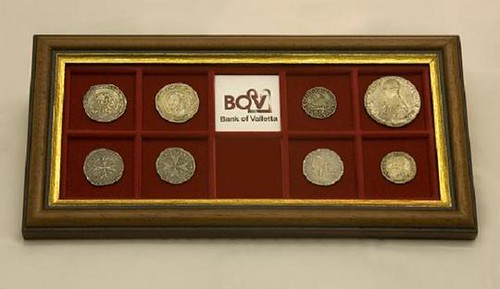
To read the complete article, see: BOV buys rare coins of the Knights (http://www.timesofmalta.com/articles/view/20081013/
local/bov-buys-rare-coins-of-the-knights)
HOLLOW SPY COIN REPLICAS OFFERED
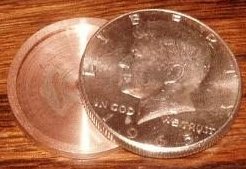 During the Cold War, Spies from both the East
and West used Hollow Coins to ferry secret messages, suicide poisons, and
microfilms undetected. On May 1st, 1960 U2 Pilot Gary Francis Powers was
shot down over the Soviet Union and taken captive. In his possession was a
hollow silver dollar containing a poisoned needle that was to be used to
take his own life in such a circumstance.
During the Cold War, Spies from both the East
and West used Hollow Coins to ferry secret messages, suicide poisons, and
microfilms undetected. On May 1st, 1960 U2 Pilot Gary Francis Powers was
shot down over the Soviet Union and taken captive. In his possession was a
hollow silver dollar containing a poisoned needle that was to be used to
take his own life in such a circumstance. 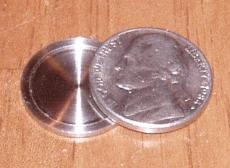 For one reason or another, he did not use it and
was held for 21 months by the Soviets. He was then exchanged for Soviet
spy KGB Colonel Vilyam Fisher (aka Rudolf Abel) at the Glienicke Bridge,
in Berlin, Germany. Colonel Fisher was also no stranger to hollow
coins...his original capture by the United States FBI was directly related
to a hollow nickel that was used to transport microfilm.
For one reason or another, he did not use it and
was held for 21 months by the Soviets. He was then exchanged for Soviet
spy KGB Colonel Vilyam Fisher (aka Rudolf Abel) at the Glienicke Bridge,
in Berlin, Germany. Colonel Fisher was also no stranger to hollow
coins...his original capture by the United States FBI was directly related
to a hollow nickel that was used to transport microfilm. On the following pages are exact duplicates of Cold War Spy Coins. They are all precision machined from actual coins, and are absolutely indistinguishable from a solid coin to the naked eye. They can be safely handled without danger of separation, and can easily circulate without detection. These exact replicas are proudly made in The USA.
To read the complete article, see: Hollow spy coins (http://www.boingboing.net/2008/10/16/hollow-spy-coins.html)
For ordering information, see: spy-coins.com
FEATURED WEB PAGE: WIKIPEDIA'S COINS OF THE HAWAIIAN DOLLAR
This week's featured web page is Wikipedia's Coins of the Hawaiian dollar.From the web page:
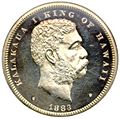 In 1847, the Kingdom of Hawai'i, under the reign of
King Kamehaheha III, issued its first official coinage -- a large one-cent
copper penny -- to alleviate the chronic shortage of small denomination
coins circulating in the Hawaiian Islands. The next and last official
coinage of the Hawaiian Islands was minted in 1883, by King Kalbkaua I;
however during the intervening period, the change needs of the Hawaiian
Islands were met by circulating private-issued tokens and the coins of the
United States of America.
In 1847, the Kingdom of Hawai'i, under the reign of
King Kamehaheha III, issued its first official coinage -- a large one-cent
copper penny -- to alleviate the chronic shortage of small denomination
coins circulating in the Hawaiian Islands. The next and last official
coinage of the Hawaiian Islands was minted in 1883, by King Kalbkaua I;
however during the intervening period, the change needs of the Hawaiian
Islands were met by circulating private-issued tokens and the coins of the
United States of America.Following is a list of known coins and tokens issued by the Kingdom of Hawai'i and various business concerns during the period of 1847 and 1891, with allied Medcalf & Russell numbers:
en.wikipedia.org/wiki/Coins_of_the_Hawaiian_dollar
